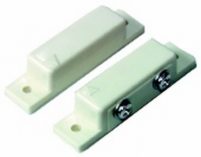Magnetic Alarm Contacts

Magnetic contact sensors are the primary way in which windows and doors can be tagged by a security system for having opened or closed. When a sensor loses contact with a simple, stationary magnet on a movable pane, its system is able to discern that the door or window attached has been opened. This can, depending on the circumstance, do absolutely nothing or trigger an alarm.
Surface Contacts

Surface contacts are the simplest to install; these are the most inexpensive form. A sensor is placed on the frame and a magnet is placed on the door or window; a chemical adhesive is generally used, with no tools being made necessary. These are not particularly pretty, however, as all their technological components and wiring are completely external and visible. For this reason, they are generally only used in industrial and commercial areas, although there are exceptions for external doors, for instance, for a garage door.
Recessed Contact

A recessed contact is mechanically the same, however, the magnet and sensor both are placed inside the frame and door or window respectively, keeping everything out of sight. This creates a much cleaner look and makes the system much more difficult to tamper with. This costs slightly more, but the aesthetic and safety increase more than often makes it worth it.
Garage Door Contact
A garage door contact functions in the same fashion, with a magnet and sensor, although rather than a door’s frame, the sensor is generally installed into the floor of the garage, with the magnet placed on the garage door. The sensor portions are usually steel-cased and submerged, to prevent destruction by constant traffic.

Sliding windows and doors should always employ magnetic contacts, but rotary casement windows should use a glass break detector; thieves cannot open these as easily, but they can break the glass or remove it, thereby circumventing your sensor.
Microwave Sensors operate by bouncing electromagnetic waves in the microwave spectrum off objects and checking the frequency of the waves that bounce back. This is the same as radar speed checking; as the doppler effect compresses sound waves and make them sound different, microwaves give off differing frequencies when the object they’re bounced off is moving. These sensors are very sensitive, which can result in the occasional false positive, but microwaves penetrate walls, allowing them to be placed in hidden locations so that they cannot be evaded. Their primary drawback is their periodic interference with other electronic equipment.
Infrared Sensors are more common and inexpensive; these are the sensors you see on cheaper installations like porch lights. Infrared sensors actually check temperature, with a methodology not unlike microwave sensors. As consequence, infrared sensors are much more accurate in their detections; however, infrared signals do not penetrate walls in the same way as microwave sensors, and their range is limited. Some of the better sensors on the market combine microwave and infrared sensors to reduce false positives.


1 thought on “What is The Purpose of Magnetic Contact Sensors?”
Comments are closed.